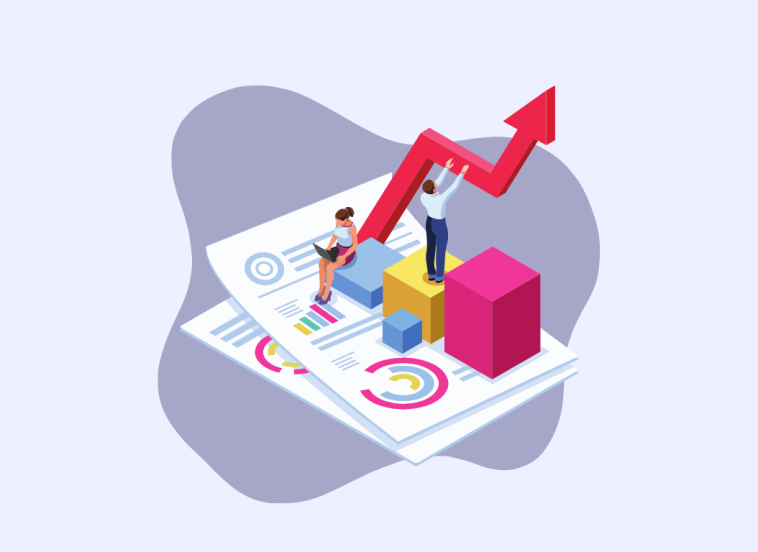Having a multigenerational workforce is less of a choice and more of a fact of life. While the general consensus is usually on the side of having a team on the younger side, today we will be discussing how having a generationally diverse team can truly benefit an organization.
Having a multigenerational workforce isn’t just an aspect of diversity management. A multigenerational workforce can truly prove to be an asset to your organization when built right.
In this article, we will be going over the basics of having a multigenerational workforce. We will cover the definition of a multigenerational workforce, some of the challenges that come with having a multigenerational workforce, the benefits of having a multigenerational workforce, and how you can manage a multigenerational workforce.
Before we move forward with the article, we would like to direct your attention to one of our favorite quotes:
All generalizations are false, including this one.
Mark Twain
This article, by nature, relies somewhat on generalizations about generations. And as Mr. Twain suggests, generalizations just might have the tendency to be false every once in a while.
While it wouldn’t be an outlandish claim to state that Zoomers are digital natives and are great with technology, it may not apply to the Gen-Z employees in your workplace!
Do you have a baby boomer in your organization that can outtech everyone else, all we can say it: That is awesome! We’d love to meet him!
Now… Let us talk about multigenerational workforces!
Table of Contents
What is a multigenerational workforce?
Understanding what a multigenerational workforce is all about is essential for unlocking the full potential of generational diversity in your organization.
In simple terms, a multigenerational workforce is one where employees from different age groups coexist and contribute to the overall productivity and success of the company. These age groups typically include Baby Boomers, Gen X, Millennials, and Gen Z, each bringing their own distinct characteristics and experiences to the workplace.
What are the different generations in the workforce?
- Baby Boomers: Born between the mid-1940s and early 1960s, Baby Boomers are known for their strong work ethic, experience, and dedication to their jobs. They often provide valuable insights and stability to the team.
- Gen X: Born between the mid-1960s and early 1980s, Gen Xers are independent and adaptable members of the workforce. They have witnessed significant technological advancements and bring a pragmatic approach to problem-solving.
- Millennials: Born roughly between the early 1980s and mid-1990s, Millennials, or Generation Y, are tech-savvy and have grown up amidst rapid technological changes. They value work-life balance, seek purpose in their careers, and thrive in collaborative environments.
- Gen Z: The youngest generation in the workforce, born after the mid-1990s until the early 2010s. Gen Z individuals are true digital natives, having been raised with technology at their fingertips. They offer fresh perspectives and creativity, particularly in the digital realm.
Here are some tips on managing each of these generations:
How to manage Baby Boomers?
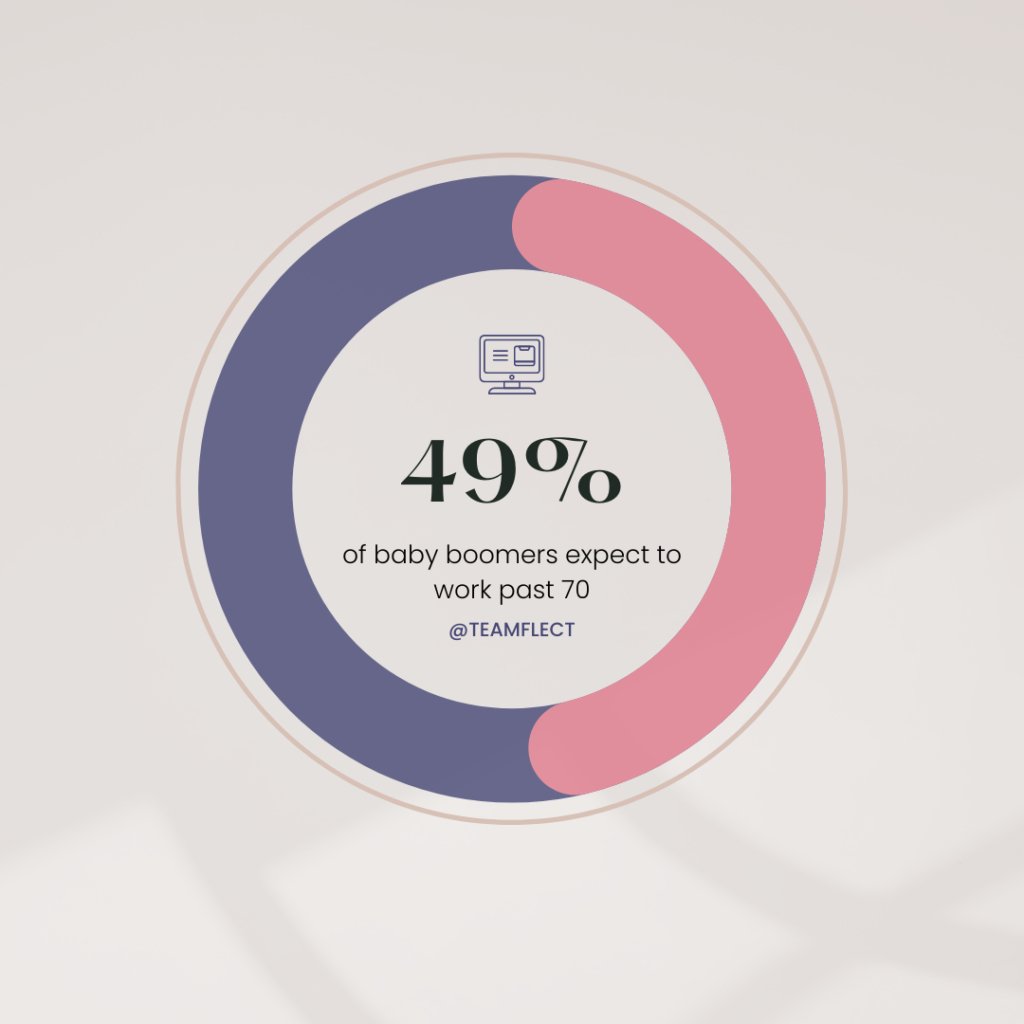
Recognize Their Experience
Baby Boomers value their years of experience and contributions to the organization. Acknowledge their expertise and provide opportunities for them to mentor younger employees.
Provide Clear Structure and Expectations
Baby Boomers may appreciate a clear hierarchy and well-defined roles. Clarify expectations and provide a structured work environment to ensure they feel comfortable and engaged.
Offer Opportunities for Growth
Despite their experience, Baby Boomers are still interested in personal and professional growth. Offer training and development opportunities to keep their skills up-to-date and show that their learning journey never ends.
Encourage Face-to-Face Communication
Baby Boomers often prefer face-to-face interactions. Balance digital communication with in-person meetings and opportunities for collaborative discussions.
How to manage Gen X?
Empower Their Independence
Gen X values autonomy in their work. Give them the freedom to take ownership of their projects and trust them to manage their responsibilities effectively.
Acknowledge Their Work-Life Balance
Gen X is known for seeking a healthy work-life balance. Offer flexible schedules and remote work options to support their desire to balance career and personal life.
Provide Opportunities for Collaboration
Despite their independence, Gen X appreciates teamwork. Foster a collaborative culture by creating cross-functional teams and encouraging knowledge sharing among employees.
Leverage Their Adaptability
Gen Xers have experienced significant technological advancements in their careers. Leverage their adaptability to embrace new tools and processes within the organization.
How to manage Millenials?
Promote Purpose and Impact
Millennials seek meaningful work. Connect their roles to the organization’s larger purpose and show how their contributions make a difference.
Embrace Flexibility and Work-Life Integration
Offer flexible work arrangements and support work-life integration. Millennials prioritize the ability to balance work with personal commitments.
Provide Opportunities for Growth and Advancement
Millennials are eager for career development. Offer mentorship programs, skill-building workshops, and a clear path for advancement within the organization.
Embrace Technology and Innovation
Millennials are tech-savvy and comfortable with digital tools. Utilize technology in the workplace and encourage innovative ideas to improve processes.
How to manage Gen Z?
Embrace Digital Collaboration
Gen Z is the first generation born into the digital age. Leverage their familiarity with technology for collaborative projects and virtual teamwork.
Offer Diverse Learning Opportunities
Gen Z values continuous learning and diverse experiences. Provide opportunities for job rotations, cross-training, and exposure to different aspects of the organization.
Foster Inclusion and Diversity
Gen Z celebrates diversity. When recruiting Generation Z, you need to ensure an inclusive work environment where all voices are heard and respected, fostering a sense of belonging.
Encourage Entrepreneurial Thinking
Gen Z tends to have an entrepreneurial mindset. Encourage them to think creatively and take ownership of their ideas and projects.
Benefits of having a multi-generational workforce.
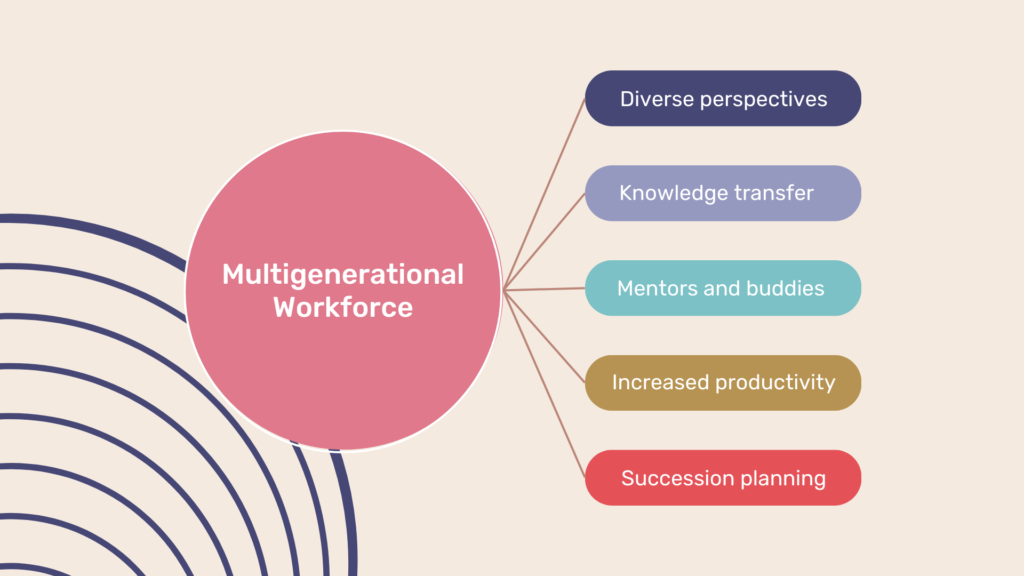
1. Diverse Perspectives and Problem-Solving
A multigenerational workforce brings with it multiple perspectives from, you guessed it, multiple generations. The seasoned wisdom of Gen X, mixed with the innovative nature of Gen Z just might be the concoction you need to foster creativity in the workplace!
Each generation has its unique life experiences, cultural backgrounds, and ways of thinking, leading to a diverse pool of perspectives. Every time you hold a check-in with your team in order to tackle a problem, you will have access to a pool of wisdom and perspectives spanning generations.
2. Knowledge Sharing and Skill Transfer
The presence of different generations enables knowledge sharing and skill transfer within the organization. Older employees with years of experience can pass on valuable insights to younger colleagues, while younger employees can introduce new technologies and fresh approaches to work.
No matter which generation your employees are from, they all appreciate opportunities for growth. Each generation, without leaning too heavily into stereotypes has its own strengths and weaknesses. Strengths and weaknesses that can be covered by the other generations.
When members of a multigenerational workforce share their skills and knowledge with each other, they cover each other’s weaknesses perfectly.
3. Enhanced Creativity and Innovation
The mix of generations fosters an environment where creativity and innovation thrive. Each generation contributes unique ideas, leading to a more dynamic and inventive workplace.
This isn’t just the case with multigenerational teams. Whenever you build cross-functional teams, the end result is an increase in productivity, creativity, and innovation.
4. Mentorship Opportunities
Having different age groups and more specifically, generations in your organization, creates a natural environment for mentorship opportunities. Especially during the onboarding process, having an effective mentorship or buddy program is an absolute must!
These relationships can be mapped out any way you see fit, based on the nature of the mentorship itself. As long as you create an environment where employees are helping each other grow, it doesn’t matter who the mentor is.
While a more conventional approach would be having the older generation mentor the younger one, you can always flip the script!
5. Succession Planning
Having access to a diverse age range allows organizations to identify potential successors across different levels and ensure a smooth transition during leadership changes.
While age shouldn’t be the sole criteria one should consider while succession planning, it can definitely play a part. In a multigenerational workforce, succession planning, whether you are using a 9-box grid or any other methodology, comes rather easily.
Challenges of having a multi-generational workforce.
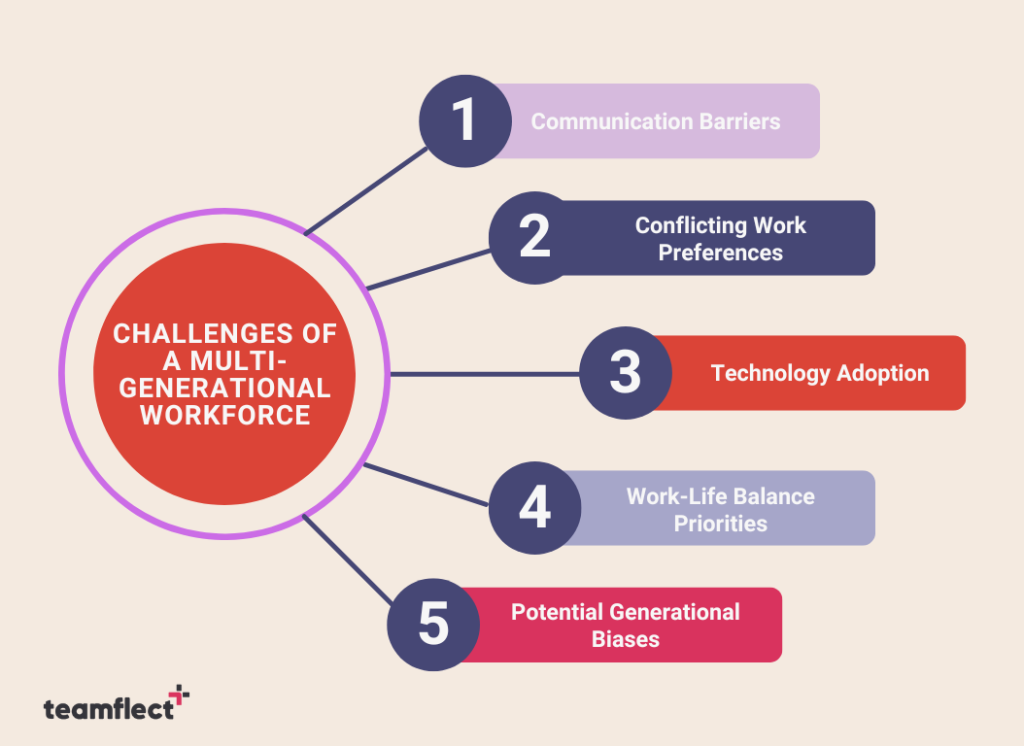
1. Communication Barriers and Misunderstandings
Generational differences can lead to communication challenges. Each age group may have distinct communication preferences and styles, such as face-to-face interactions versus digital communication. Misunderstandings can arise when messages are interpreted differently, leading to miscommunication and potential conflicts.
Lapses in communication are among some of the most prominent reasons for employee burnout. Removing those communication barriers or better yet, not letting them form in the first place is the best way to avoid having disengaged employees.
2. Conflicting Work Preferences and Expectations
Workplace expectations and preferences often vary across generations. For example, Baby Boomers might value hierarchy and structure, while Millennials and Gen Z prefer a more flexible and autonomous work environment. Balancing these diverse preferences and finding common ground can be a delicate task for employers.
3. Technology Adoption and Digital Divide
The rapid pace of technological advancements can create a digital divide between generations. Younger employees who grew up with technology may adapt quickly to new tools, while older employees might find it challenging to keep up. This divide can impact collaboration and productivity if not properly addressed.
4. Differences in Work-Life Balance Priorities
Work-life balance is highly valued across all generations, but the definition of balance may vary. Younger generations might seek more flexible schedules and remote work options, while older generations may prioritize face-to-face interactions and traditional office settings. Finding a compromise that meets the needs of everyone can be a complex task.
5. Potential Generational Biases and Stereotypes
Unconscious biases and stereotypes about different generations can emerge in the workplace. For instance, younger employees may be seen as entitled, while older employees may be labeled as resistant to change. These assumptions can hinder teamwork and create a divisive work environment.
Managing a multigenerational workforce.
Now that we’ve discussed the benefits of a multigenerational workforce, as well as multigenerational workforce challenges, it is time to talk about some of the core areas that go into managing a multigenerational workforce.
1. Check in regularly.
Almost all of the challenges we highlighted above can be solved through weekly check-ins. Especially when practicing remote team management, making sure to stay on top of your team is truly a must!
Regular weekly check-ins are not only great ways to solve issues such as miscommunications, and conflicting interests, but Regular check-ins don’t just keep the communication lines open. They are also great opportunities for working together on setting short and long-term goals.
2. Give everyone a chance to shine.
As we mentioned previously, members of each generation have their own unique sets of skills and they all would love to play “The Hero” for once.
You, as the leader of a multigenerational workforce, should be creating situations where every single one of those skills gets. Whenever you are setting goals for the upcoming quarter, make sure your goal setting template includes achievable goals for each of your employees to shine through.
3. Create an inclusive environment: Accommodate different work styles.
Building an inclusive workplace culture is the foundation for successful multigenerational management. Encourage open communication and respect for diverse viewpoints. This will in turn return to you as a sense of belonging for all employees.
In a multigenerational workforce, it is very easy to get lost in an “Us VS Them!” attitude. You need to ensure that everyone feels valued and appreciated, regardless of their age or background.
Every member of your multigenerational workforce may be better suited for a different work style. That is why when you are leading multigenerational workforces, you should accommodate all those styles.
4. Create cross-generational project teams.
What is the point of having a multigenerational workforce, if you’re not going to let them work together?
Facilitate opportunities for employees of different generations to work together on projects and initiatives. Encouraging intergenerational collaboration will lead to knowledge exchange and foster a sense of camaraderie among team members.
Provide them with the right tools: Teamflect
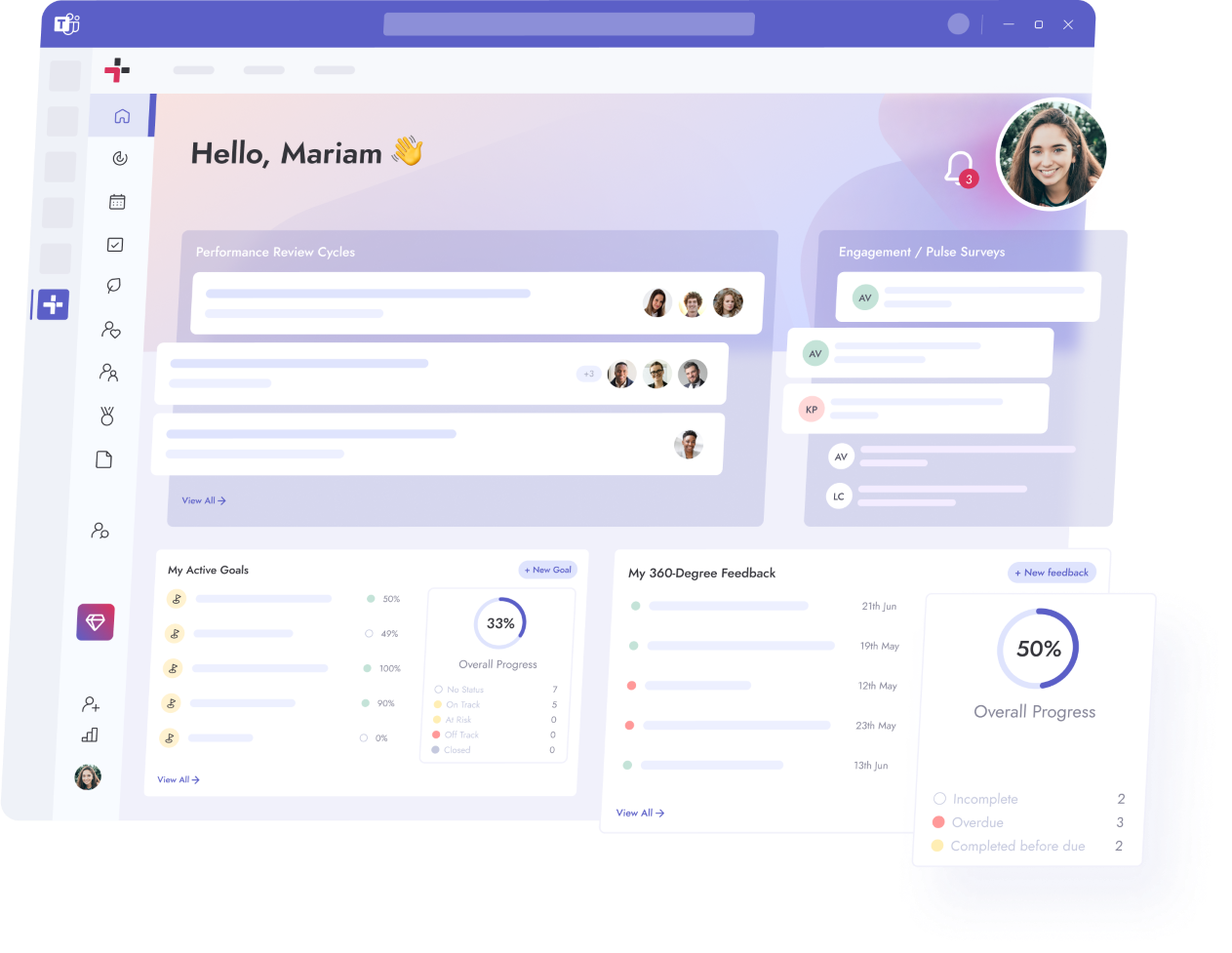
Whether your multigenerational team is working remotely or in-house, you will need to provide them with the best possible performance management system you can! This is where Teamflect comes in.
Teamflect is an all-in-one performance management software, designed specifically for Microsoft Teams. Teamflect is the perfect platform for multigenerational project teams.
Not only does Teamflect come with robust meeting features such as creating customizable Microsoft Teams meeting agendas, it also lets users create customizable relationship labels among each other.
Other Teamflect features include but aren’t limited to:
- Performance review template gallery
- Goal setting.
- Employee recognition.
- Continuous feedback.
- OKR management.
- And so much more!
The best part is, Teamflect is completely free with full functionality for up to 10 users. No Teanflect lite version, no limited trials! Completely free with full functionality. That means you can demo Teamflect with a single department and if they like it, then you can invest in it!



